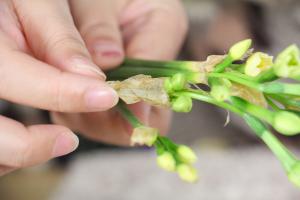Why Do My Tomato Plant Leaves Look Wilted?
Tomato plants are a versatile and popular garden staple. They grow easily in many different climates and produce fruit that is both delicious and nutritious. However, sometimes gardeners may notice that their tomato plant leaves appear wilted, which can cause concern. There are many reasons why this may be happening, and understanding the causes can help you take the appropriate steps to remedy the situation.
Poor Watering
One of the most common reasons for wilted tomato plant leaves is poor watering practices. Tomatoes require consistent moisture, especially during hot and dry weather. If your plant is not getting enough water, it can lead to wilting. However, overwatering can also cause wilting, as the roots may be unable to absorb oxygen. To ensure proper watering, use a moisture meter or check the soil regularly. If it feels dry, water your plants deeply and consistently, but avoid getting the foliage wet.
Plant Disease
Another reason why tomato plant leaves may appear wilted is due to disease. Various types of fungal and bacterial diseases can affect tomato plants, causing the leaves to yellow, brown, or wilt. Some common diseases that may cause this symptom include early blight, Septoria leaf spot, and Fusarium wilt. Unfortunately, these diseases can spread easily throughout the plant and to neighboring plants, so it is important to identify and treat the problem as soon as possible. Remove any affected plant parts and use an appropriate fungicide to prevent further spread.
Pests
Tomato plants can also be affected by pests, which can cause wilting and other symptoms. Some common pests include aphids, spider mites, and whiteflies. These pests feed on the sap of the plant, which can lead to weakened and wilted leaves. Regularly inspect your plants for pests and use appropriate insecticides to avoid infestation. Additionally, planting companion plants that repel pests, such as marigolds or basil, can help deter them from your tomatoes.
Nutrient Deficiencies
Tomato plants require certain nutrients to grow and thrive. If they are not getting enough of these nutrients or are experiencing deficiencies, it can lead to wilting or yellowing leaves. Common nutrient deficiencies include nitrogen, phosphorus, and potassium. To avoid nutrient deficiencies, ensure that your soil is well-balanced and that you are providing your plants with a balanced fertilizer. You may also consider using organic methods, such as compost, to provide your plants with the nutrients they need.
Temperature and Sunlight
The temperature and sunlight conditions can also affect your tomato plants’ health. If the temperature is too high or too low, it can cause the leaves to wilt. Additionally, if your plants are not receiving enough sunlight, they may not be able to produce enough energy for proper growth, leading to wilted leaves. To avoid these issues, plant your tomatoes in an area that gets plenty of sun and avoid planting them in areas that are too exposed or too shaded. You may also consider using shading or a covering to protect your plants in extreme weather conditions.
Conclusion
Wilted tomato plant leaves can be a sign of a variety of problems, from poor watering practices to plant disease or pests. By identifying the cause of the problem and taking the appropriate steps, such as adjusting your watering habits, applying insecticides, or providing appropriate nutrients, you can help your tomato plants thrive and produce delicious fruit. Regularly inspecting your plants and ensuring that they are in optimal conditions can also help prevent these issues from occurring in the first place.

 how many times do yo...
how many times do yo... how many planted tre...
how many planted tre... how many pine trees ...
how many pine trees ... how many pecan trees...
how many pecan trees... how many plants comp...
how many plants comp... how many plants can ...
how many plants can ... how many plants and ...
how many plants and ... how many pepper plan...
how many pepper plan...






























